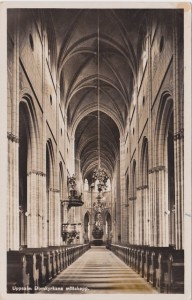15 Nov Uppsala
Uppsala, the fourth largest city of Sweden, is the site of the country’s oldest university, founded in 1477. (An older spelling is Upsala.) The city is located on either side of the river Fyrisån, the more historic part of town being to the west.
At the time of World War II, there were 41,800 inhabitants. The most interesting places to visit were the 13th century cathedral, the castle from the Vasa Age, university buildings, including Carolina Rediviva, the university library.
Boats could sail from Lake Mälaren up to central Uppsala and would have given a more scenic journey than the train. In 1944, it was about a one hour train ride from the Central Railway Station in Stockholm.
2.5 miles north of Uppsala is the original location of the town, now known as Gamla Upsala or Old Uppsala. What is now Uppsala was then called Östra-Aros and was in earlier centuries the commercial town and harbor of the kings of Sweden when they resided at Gamla Upsala.
The Uppsala Cathedral is the tallest church building in Scandinavia. It was erected in 1260 – 1435. It was built by the Roman Catholic Church but is now the seat of the Archbishop of the Lutheran Church of Sweden. Its architect was one of the assistant builders of the Notre Dame at Paris. The Cathedral has been the coronation church for many of Sweden’s monarchs.
In 1944, just a short walk from the Cathedral was the Gillet, a hotel with a popular restaurant. It was closed in 1973 and since has been both an art gallery and a clothing store. Today there is a hotel across the river that has taken the name Gillet, now the Clarion Hotel Gillet.
Carolina Rediviva is the University library, the largest in Sweden and completed in 1841. A chief treasure is the Codex Argenteus, a translation of the four Gospels into Gothic, dating back to the 4th century, written on 187 leaves of parchment in gold and silver letters. This manuscript was captured at Prague in 1648 and presented by Queen Christina to her librarian, and then was purchased from him for 400 crowns by the chancellor of the university.
Right in the city is the historical Uppsala Castle, built by King Gustav Vasa beginning in 1549. A fire in 1702 caused serious damage and reconstruction took many years. In front of the castle are some large ancient cannons, one of which my Dad was standing in front of for this photograph in 1944.
So it sounds like a tour of Uppsala would be a full afternoon, doesn’t it? And I plan to be there next May or June just so I can find my Dad’s cannon!
Update: My visit to Uppsala in 2012.




Tommy Jonason
Posted at 04:09h, 17 NovemberHi again,
Östra Aros means east of the river Aros. Uppsala is a wonderful city were I studied at the University.
I live in Västra Aros (west of aros), or Västerås. There, Sweden hand one of the longest airfield suitable for bombers. Therefore, most of the landed American aircrafts were placed there, as you can see on the photo (hope it is OK) The Germans actually suspected that Sweden would allow a base for the Allied Bomber Force during the last years of the war.
http://larssundin.ownit.nu/Hasslo_varen_45.jpg
Lifecruiser Travel
Posted at 12:29h, 18 NovemberUppsala is a nice little town, so it’s a pleasant trip to do anyway 🙂
I actually came here to ask if this site (salship.se) could be of any use for you and especially the page about WWII: http://salship.se/mercy.asp
Pat
Posted at 18:16h, 18 NovemberI will check it out and I’m sure it will be useful … as always, THANKS!
Ulf Gahm
Posted at 16:13h, 22 DecemberUppsala is a very nice city. Here is a photo of the cannons taken in recent years.
http://uppsala.yimby.se/Publishing/FileStore/200/1f075b61-6462-40b8-be06-f2e56dcdc768.png